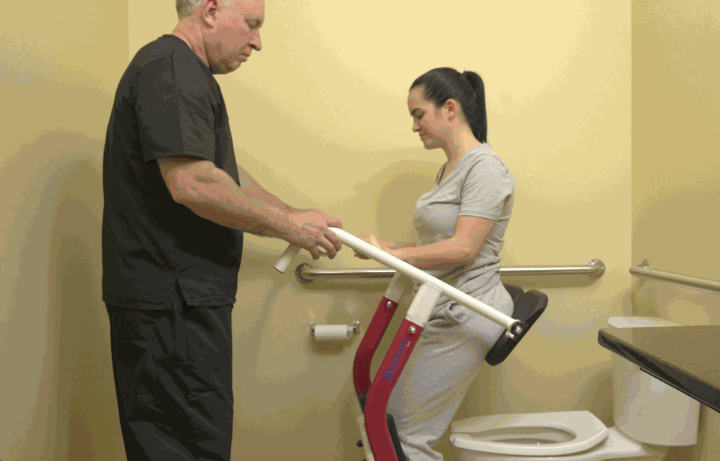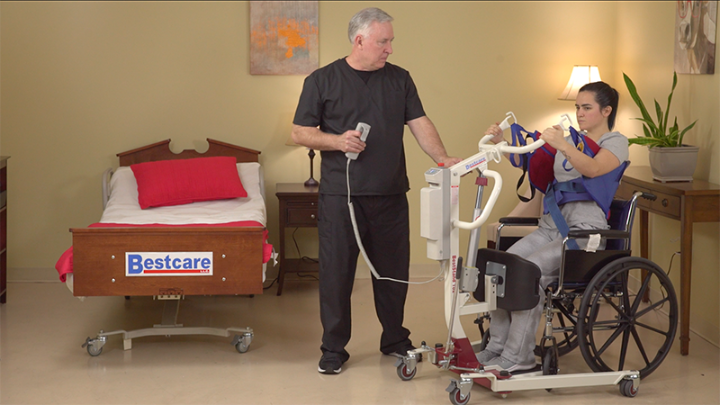Safe and comfortable transfers are a major part of daily care for individuals with limited mobility. The right lift protects the user, reduces strain on caregivers, and makes moving around the home much easier. At Freedom Mobility Solutions, we offer a variety of BestCare lift options, including models like the BestMove Spryte, BestLift PL500, and BestStand SA182, so individuals and families can find a lift that fits their needs.
Below is a clear guide to each lift type and when it is typically used.
1. Non-Powered Stand Assist Devices
Non powered stand assist devices are helpful when the user can still bear some weight and participate in standing. These devices do not lift the person electronically. Instead, they provide structure, balance, and knee support while the user pushes up with their own strength. Models like the BestMove 400 lb Spryte and BestMove 450 lb Spryte are compact and easy to maneuver, which makes them ideal for tight spaces such as bedrooms and bathrooms.
You may need a non powered stand assist if the user:
• Can stand with moderate assistance
• Has good upper body strength
• Wants to remain active in the transfer process
• Only needs quick and simple transfers throughout the day
• Benefits from a smaller and more affordable option
These devices work well for short transfers and for users who need steady support without requiring a powered lift.

2. Full Body Patient Lifts
Full body lifts are designed for users who cannot bear weight at all or cannot safely participate in standing. These lifts use a full body sling to support the user during the entire transfer. Models like the BestLift PL400, PL500, and PL600 offer smooth lifting and dependable weight support for individuals with more advanced mobility needs.
You may need a full body lift if the user:
• Cannot stand or support any of their weight
• Has significant mobility challenges or paralysis
• Is recovering from surgery or illness and must avoid weight-bearing
• Needs full support from lying to seated positions
• Requires lifting from the floor after a fall
Full body lifts are commonly used in long-term care, home care, and clinical environments where safety and complete support are essential.

3. Sit to Stand Lifts
Sit to stand lifts are designed for users who can bear some weight but need extra support to rise from a seated position. These lifts use an electric mechanism to gently guide the user into a standing posture. Models like the BestStand SA182, SA228, SA400, and SA600 are often used for toileting, dressing routines, and daily transfers.
You may need a sit to stand lift if the user:
• Can support some weight through their legs
• Can sit upright independently
• Needs help rising from chairs, beds, or commodes
• Struggles with the effort required to stand on their own
• Needs safer and more consistent transfers throughout the day
Sit to stand lifts are ideal when the user can still participate physically but needs a powered assist for safe and stable movement.

4. Slings and Lift Accessories
Slings are a crucial part of any lift system. The right sling ensures proper positioning, comfort, and safety during transfers. Stand assist slings pair with sit to stand lifts, while full body slings are designed for complete support during full body lifting. Choosing the correct sling style and size ensures a secure and comfortable transfer every time.
Examples include:
• Stand assist slings for powered standing lifts
• Full body slings for total support and seated transfers
• Mesh slings for bathing
• Toileting slings for bathroom access
Matching the sling to both the user and the lift type is essential for safe operation.
How to Choose the Right Lift
Understanding the user’s abilities is the best starting point when selecting a lift:
| User Ability or Need | Best Lift Type |
|---|---|
Can stand with assistance and has good upper body strength | Non Powered Stand Assist |
Cannot stand or bear weight at all | Full Body Lift |
Can partially stand and bear weight | Sit to Stand Lift |
Needs comfortable toileting or bathing support | Specific Sling Type |
Other considerations include home layout, caregiver strength, transfer frequency, and whether lifting from the floor may be required.
Why Choose Freedom Mobility Solutions
Freedom Mobility Solutions provides safe, personalized solutions tailored to your home and your level of care. We offer hands-on demonstrations at our Hanover and Ashburn showrooms, along with setup, training, rental options, and service support. Demonstrations are performed using equipment only and not on the actual patient, ensuring a comfortable and safe learning experience for everyone. Our selection includes trusted BestCare models such as the BestMove Spryte, BestLift PL series, and BestStand stand assist lifts.
Freedom Mobility Solutions is Here to Help
Each lift plays a different but important role in maintaining mobility, independence, and safety. Whether you need a simple non powered assist, a full body lift for total support, or a sit to stand lift for daily routine transfers, Freedom Mobility Solutions has options to meet your needs.
If you are unsure which lift is right for your situation, our team is here to help guide you every step of the way.